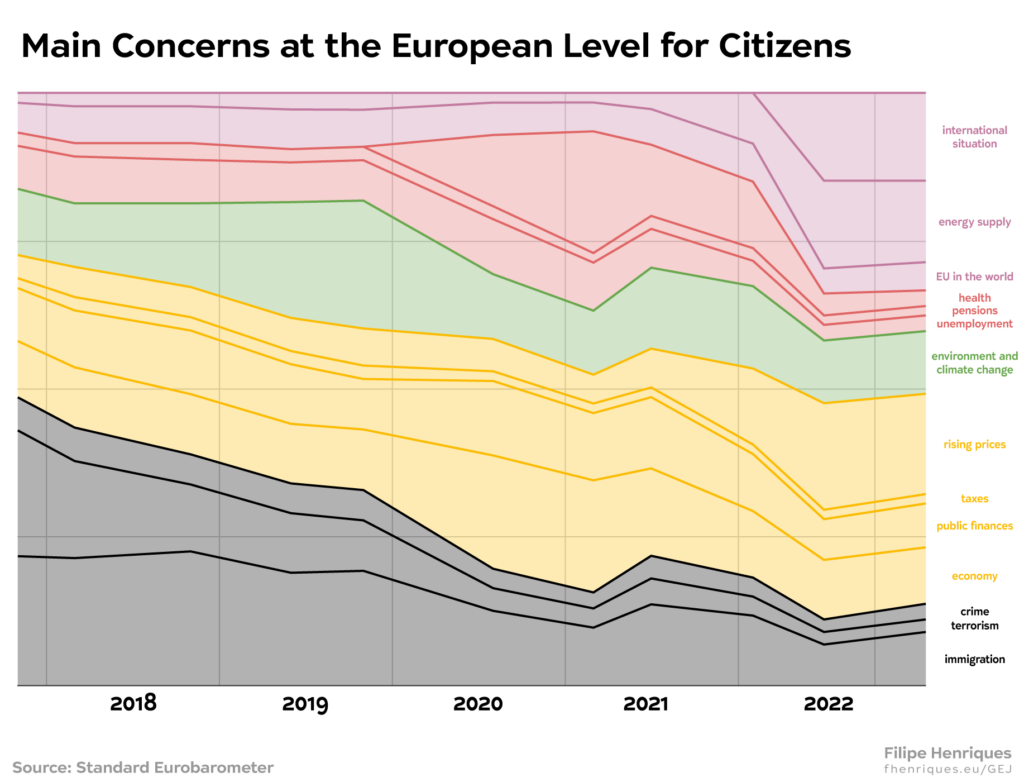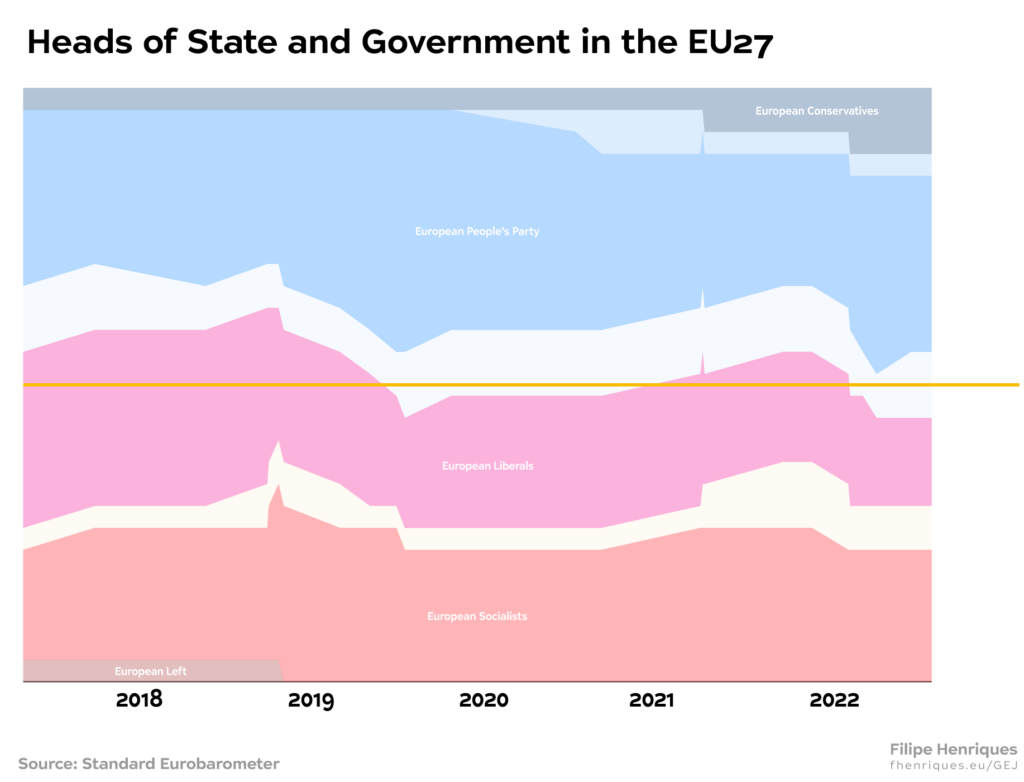In 2024, voters will once again have a say in the future of the EU institutions and the bloc’s future. Recent right-wing election victories hint at potential outcomes, but as Covid-19, the war in Ukraine, and the green movement have shown, rapid changes are never far in politics. In the first of a new monthly column on the European elections, Filipe Henriques examines the current political landscape and searches for reasons for optimism.
Elections in post-pandemic and wartime Europe seem to repeat a pattern: progressive governments fall, leadership turns to the right and the far-right grows in strength. As things stand, the European Council has a solid conservative majority and the few progressive governments seem to be struggling. One year before the 2024 European elections, pessimism is spreading in progressive circles.
Our latest issue – Aligning Stars: Routes to a Different Europe – is out now!
Read it online or get your copy delivered straight to your door.
Five years ago, we were in a similar mood one year away from the 2019 European elections. The public debate was focused on migration and terrorism, and the far-right was profiting from it. The Greens had just lost all parliamentary presence in Austria and France, and didn’t seem to be growing anywhere else. The progressive space seemed to have migrated to the Liberals, especially in France and Spain where President Macron was still popular and Ciudadanos’ Albert Rivera was the next superstar. In Italy, the anti-establishment Five Star Movement had just won the national elections, with the far-right Lega Nord coming in second. In Germany, the far-right Alternative für Deutschland (AfD), at the 15 per cent threshold, posed a threat to the stability of the country under Angela Merkel. In Poland, the power of Law and Justice party leader Jarosław Kaczyński seemed consolidated.
While defeat seemed certain, the political landscape did change. By the end of 2018, youth movements had made climate one of the most central topics, while terrorism dropped down the agenda. By the time we reached the 2019 European elections, the growth of the Liberals and the far-right was confirmed but a bigger story was the growing youth participation at the polls and the biggest Green parliamentary group in the history of the European Parliament. The unparalleled weakness of the two largest groups – European People’s Party (EPP) and Socialists – brought new power balances to Brussels.
As 2020 started, the global pandemic again changed the debate: health, the economic situation and public finances took the centre stage. Politics became focused on responding to the pandemic and its effects on people’s lives. As normality seemed to return in early 2022, Russia unleashed the most devastating war on European soil since the Yugoslav Wars. Besides the immense destruction in Ukraine and rising fears among other countries bordering Russia, inflation grew rapidly across the continent and brought a new wave of worries about the economic situation.

Rapid change is the one constant of recent years.
What now?
The recent elections in Finland have put an end to a progressive government of Social Democrats, Greens, the Left and agrarian centrists. With this, another government of the EPP together with the radical right will most likely take power, as has happened in Italy and Sweden.
The radicalisation of the EPP, who has abandoned its former shame about working with the far-right, is a new reality in European politics. Under Manfred Weber’s leadership, the EPP has retreated from its historical role of the centre-right of European politics to become a right-wing force that prioritises cooperation with those to their right. As a major political party at the European level, but also in most national governments in Europe, this development is in itself a danger to democracy. While at the European level a right-wing majority supported by the far-right is still unlikely, the simple fact that anti-democratic forces are normalised by a major party will push the political centre of gravity in a reactionary direction.
Several key countries will hold national elections before the next European elections. These contests will be important not only to guarantee progress in several European countries, but also for the composition of the European Council and the general political outlook across Europe.

Elections in Greece this May will be an important test. The conservative government of Kyriakos Mitsotakis has been a prototype of a radicalised EPP, with the receipts to show it: from building a wall on its Turkish border that would delight Donald Trump, to spying on journalists and opposition leaders and failing to protect public services which ultimately led to the death of 57 people in a rail accident in northern Greece. A progressive majority that would bring Alexis Tsipras back to power would be an important turn of events.
In Slovakia, it is all but certain that the European People’s Party will lose power, as the battle is between Robert Fico’s Smer-SD and Peter Pellegrini’s HLAS-SD, both members of the European Socialists. The fact that Robert Fico is still part of the Socialist family shows that it is not only the EPP that has to answer for their lack of democratic values. His anti-democratic stances should have guaranteed the isolation of Smer-SD at the European level for a long time, yet this has not happened. Nonetheless, a progressive alternative around Peter Pellegrini’s HLAS-SD and the social-liberal Progressive Slovakia is possible.
In Luxembourg, after a Liberal-Socialist-Green coalition put an end to three decades of uninterrupted EPP power in 2013, the 2023 elections could bring a more progressive government which could even include the first ever fully left-of-centre government including Socialists, Greens and Pirates.
A more progressive Europe is still possible, and we can see its spark around our continent.
In October of 2023, Poland will see of the most important political battle for Europe’s future. The radical right PiS seems poised to keep power, but the centrist Civic Coalition – which includes the centre-right Civic Platform, Liberals and Greens – and the centre-left Lewica could bring forward an alternative Poland. As the eyes and worries of Europe look to its eastern border, a more progressive Polish government would be key not only for leadership in our collective answer to Russia’s aggression on European soil, but also as a strong player for the protection of rule of law.
Finally, in Spain, Europe’s most progressive government is in danger. The viability of a renewed progressive coalition seems to rely on the capacity of the current Minister of Labour Yolanda Díaz to reactivate the progressive electorate with her Green-Left alliance Sumar. Otherwise, another alliance of the EPP’s Popular Party with the far-right Vox could take power after the December elections in the EU’s fourth largest member state.
The evolution of the war in Ukraine, the answers to the inflation crisis, and how progressive parties in key countries manage to revive their electorates will play an important role in how we reach the 2024 European elections. While pessimism is strong, nothing is set in stone. Around Europe, civil society has regained power after the pandemic made it dormant, the trade union movement has regained strength after Emmanuel Macron ignored parliamentary democracy, the climate movement has restarted its mobilisation, progressive parties in Eastern countries like Latvia and Croatia – Progresīvie and Možemo respectively show the capacity to mobilise new majorities, figures like Elly Schlein in Italy have taken over established parties and reached out to new voters, and Greens and Social Democrats in the Netherlands have understood that unity is needed in the progressive space.
A more progressive Europe is still possible, and we can see its spark around our continent.
